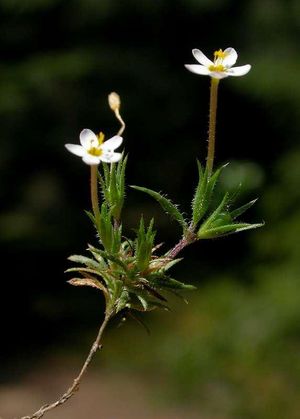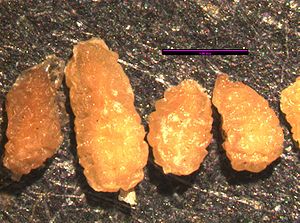Difference between revisions of "Leptosiphon bicolor"
| (19 intermediate revisions by 4 users not shown) | |||
| Line 1: | Line 1: | ||
| − | + | * Scientific Name: ''Leptosiphon'' ''bicolor'' | |
| − | + | * Family: Polemoniaceae | |
| − | + | * Common Names: bicolored babystars, bicolored linanthus | |
| − | + | * Synonyms/Misapplications: ''Linanthus'' ''bicolor'' | |
| − | + | * Codon: LEPBIC | |
| − | + | ||
| − | + | ||
---- | ---- | ||
| + | [[File:LEBI BenLegler flw good1.jpg |thumb|Photo by Ben Legler, also featured on Main Page]] | ||
| + | ===Taxonomy=== | ||
| + | {{Taxobox | ||
| + | | image = | ||
| + | | image_caption =Photo by Ben Legler. Also featured on Main Page | ||
| + | | name = | ||
| + | | regnum = [[Plant]]ae | ||
| + | | subregnum = Viridiplantae | ||
| + | | phylum = Tracheophyta | ||
| + | | subphylum= Spermatophytina | ||
| + | | classis = Magnoliopsida | ||
| + | | subclassis = Asteranae | ||
| + | | ordo = Ericales | ||
| + | | familia = Polemoniaceae | ||
| + | | genus = ''Leptosiphon'' Benth. | ||
| + | | species = ''''' Leptosiphon bicolor''''' Nutt. | ||
| + | | subspecies = | ||
| + | | synonyms = *''Linanthus bicolor'' (Nutt.) Greene | ||
| + | *''Linanthus bicolor'' ssp. ''bicolor'' (Nutt.) Greene | ||
| + | }} | ||
| + | <ref>Integrated Taxonomic Information System. Retrieved from https://www.itis.gov/servlet/SingleRpt/SingleRpt?search_topic=TSN&search_value=845247</ref> | ||
| − | + | ===Description=== | |
| − | + | Annual, slender taprooted herb. | |
| − | + | ||
| − | + | ||
| − | + | ||
| − | + | ||
| − | + | ||
| − | + | ||
| − | + | ||
| − | + | ||
| − | + | ||
| − | ==Description== | + | |
| − | + | ||
| − | + | ||
| − | + | ||
| − | + | ||
| − | + | ||
| − | + | ||
| − | + | ||
| − | + | ||
| − | + | ||
| − | + | ||
| − | + | ||
| − | + | ||
| − | + | ||
| − | + | ||
| − | + | ||
| − | + | ||
| − | + | ||
| − | + | ||
| − | + | ||
| − | + | ||
| − | + | ||
| − | + | ||
| − | + | ||
| − | + | ||
| − | + | ||
| − | + | ||
| − | + | ||
| − | + | ||
| − | + | ||
| − | + | ||
| − | + | ||
| − | + | ||
| − | + | ||
| − | + | ||
| − | + | ||
| − | + | ||
| − | + | ||
| − | + | ||
| − | + | ||
| − | + | ||
| − | + | ||
| − | + | ||
| − | + | ||
| − | + | ||
| − | + | ||
| − | + | ||
| − | + | ||
| − | + | ||
| + | Opposite, sessile, palmately lobed leaves, leaf segments linear-elongate.<ref name=":0">Hitchcock, C. L., Cronquist, A., Giblin, D., & Legler, | ||
| + | B. et al. (2018). ''Flora of the Pacific Northwest: an illustrated manual''. | ||
| + | Seattle: University of Washington Press.</ref>The leaves of the inflorescence larger and often more lobed than the cauline leaves.<ref name=":1">Klinkenberg, Brian. (Editor) 2020. ''E-Flora BC: Electronic Atlas of the Plants of British Columbia'' [eflora.bc.ca]. Lab for Advanced Spatial Analysis, Department of Geography, University of British Columbia, Vancouver. [Accessed: 2020-06-09 2:18:57 PM ]</ref> | ||
| + | Inflorescence dense, bracteate heads, flowers subsessile, corolla tube 12-30 mm, flowers pink to white, generally bicolored. Calyx more or less glabrous, sometimes scarcely hispid on outer surface or with marginal cilia.<ref name=":0" /> | ||
| + | Fruits are 3-chambered capsules, bearing several seeds per capsule.<ref name=":1" /> | ||
| + | From Greek ''lepto'', narrow, ''siphon'', tube, for shape of corolla tube.<ref name=":0" /> | ||
| + | ===Bloom Period=== | ||
| + | April- June<ref>WTU Herbarium, Burke Museum, | ||
| + | & University of Washington. Retrieved from <nowiki>https://biology.burke.washington.edu/herbarium/imagecollection/taxon.php?Taxon=Leptosiphon%20bicolor</nowiki></ref> | ||
| + | ===Distribution=== | ||
| + | West Cascades, southwest B. C., to California, east through the Columbia Gorge, and east side of Cacsades in Oregon.<ref name=":0" /> | ||
| + | ===Habitat=== | ||
| + | Open, grassy places at lower elevation.<ref name=":0" /> | ||
===Seed=== | ===Seed=== | ||
| − | |||
| − | |||
| − | |||
'''Seed sample from:''' 2011 | '''Seed sample from:''' 2011 | ||
| − | + | [[File:LEBI LisaHintz sd 2012.jpg|300px|thumb|''Leptosiphon'' seeds, photo by Lisa Hintz]] | |
| − | [[File:LEBI LisaHintz sd 2012.jpg|300px|thumb| | + | |
'''Average Measurement:''' 1.3 x 0.8 x 0.7 | '''Average Measurement:''' 1.3 x 0.8 x 0.7 | ||
'''Measurement Range: L:''' 1.1 – 1.75, W: 0.6 – 1, D: 0.5 – 1 | '''Measurement Range: L:''' 1.1 – 1.75, W: 0.6 – 1, D: 0.5 – 1 | ||
| − | |||
| − | |||
====Features==== | ====Features==== | ||
| − | |||
'''Shape:''' Seeds somewhat tear shaped, others elliptical. | '''Shape:''' Seeds somewhat tear shaped, others elliptical. | ||
| Line 93: | Line 60: | ||
'''Surface:''' Seeds bumpy and somewhat corrugated, giving them a “brain-like” texture. Seeds slightly glossy. | '''Surface:''' Seeds bumpy and somewhat corrugated, giving them a “brain-like” texture. Seeds slightly glossy. | ||
| − | |||
'''Latitudinal Cross Section:''' elliptical [[File:LEBI lat.png]] | '''Latitudinal Cross Section:''' elliptical [[File:LEBI lat.png]] | ||
'''Longitudinal cross section:''' elliptical [[File:LEBI long.png]] , and at times, obovate [[File:LEBI long ob.png]] | '''Longitudinal cross section:''' elliptical [[File:LEBI long.png]] , and at times, obovate [[File:LEBI long ob.png]] | ||
| + | ===Photo Gallery=== | ||
| + | <gallery> | ||
| + | File:LEPBIC2.jpg|Photo by Ray Izumi, 2013 | ||
| + | File:LEBI LisaHintz sd 2012.jpg|Photo by Lisa Hintz | ||
| + | </gallery> | ||
| − | + | === References === | |
| − | + | <references /> | |
| − | + | ||
Latest revision as of 21:58, 20 March 2021
- Scientific Name: Leptosiphon bicolor
- Family: Polemoniaceae
- Common Names: bicolored babystars, bicolored linanthus
- Synonyms/Misapplications: Linanthus bicolor
- Codon: LEPBIC
Contents
Taxonomy
| Scientific classification | |
|---|---|
| Kingdom: | Plantae |
| Subkingdom: | Viridiplantae |
| Phylum: | Tracheophyta |
| Subphylum: | Spermatophytina |
| Class: | Magnoliopsida |
| Subclass: | Asteranae |
| Order: | Ericales |
| Family: | Polemoniaceae |
| Genus: | Leptosiphon Benth. |
| Species: | Leptosiphon bicolor Nutt. |
| Synonyms | |
| |
Description
Annual, slender taprooted herb.
Opposite, sessile, palmately lobed leaves, leaf segments linear-elongate.[2]The leaves of the inflorescence larger and often more lobed than the cauline leaves.[3]
Inflorescence dense, bracteate heads, flowers subsessile, corolla tube 12-30 mm, flowers pink to white, generally bicolored. Calyx more or less glabrous, sometimes scarcely hispid on outer surface or with marginal cilia.[2]
Fruits are 3-chambered capsules, bearing several seeds per capsule.[3]
From Greek lepto, narrow, siphon, tube, for shape of corolla tube.[2]
Bloom Period
April- June[4]
Distribution
West Cascades, southwest B. C., to California, east through the Columbia Gorge, and east side of Cacsades in Oregon.[2]
Habitat
Open, grassy places at lower elevation.[2]
Seed
Seed sample from: 2011
Average Measurement: 1.3 x 0.8 x 0.7
Measurement Range: L: 1.1 – 1.75, W: 0.6 – 1, D: 0.5 – 1
Features
Shape: Seeds somewhat tear shaped, others elliptical.
Color: Seeds partially translucent and brown. Hilium inconspicuous.
Surface: Seeds bumpy and somewhat corrugated, giving them a “brain-like” texture. Seeds slightly glossy.
Latitudinal Cross Section: elliptical 
Longitudinal cross section: elliptical ![]() , and at times, obovate
, and at times, obovate ![]()
Photo Gallery
References
- ↑ Integrated Taxonomic Information System. Retrieved from https://www.itis.gov/servlet/SingleRpt/SingleRpt?search_topic=TSN&search_value=845247
- ↑ 2.0 2.1 2.2 2.3 2.4 Hitchcock, C. L., Cronquist, A., Giblin, D., & Legler, B. et al. (2018). Flora of the Pacific Northwest: an illustrated manual. Seattle: University of Washington Press.
- ↑ 3.0 3.1 Klinkenberg, Brian. (Editor) 2020. E-Flora BC: Electronic Atlas of the Plants of British Columbia [eflora.bc.ca]. Lab for Advanced Spatial Analysis, Department of Geography, University of British Columbia, Vancouver. [Accessed: 2020-06-09 2:18:57 PM ]
- ↑ WTU Herbarium, Burke Museum, & University of Washington. Retrieved from https://biology.burke.washington.edu/herbarium/imagecollection/taxon.php?Taxon=Leptosiphon%20bicolor




